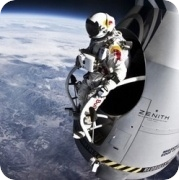
The road to the biggest jump
In 2012 we witnessed the historic event of one of the most extreme feats so far attempted by the man since he started to fly. The Red Bull Stratos project with the parachutist Felix Baumgartner as the protagonist, broke several records that remained unbroken more than 50 years.
Through this timeline, we want to pay tribute to those men and women who contributed in one way or another to pave the way that led to one of the greatest challenges still to be achieved: the stratospheric jump.
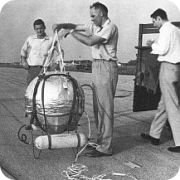
Operation Stratomouse
For many people who lived firsthand the strange passion for ballooning and for those whom loved this activity as an important part of their professional careers or lives, one of the things that most will miss is some sort of romanticism and adventure that were the trademark of those pioneering years. Dr. Webb Haymaker's "Operation Stratomouse" -which appeared in Military Medicine in September 1956 and we reproduce here more than 50 years later- still today is one of the most accurate and finest chronicles of the day-to-day life during a balloon launch campaign, ever written.
A true tale from the old days when GPS or real time tracking from a desktop computer connected to internet were only part of the wildest dreams of science fiction. Those glorious days on which every balloon launched was an adventure itself which hardly could finish as expected.
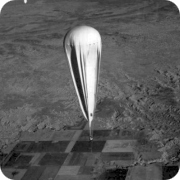
The two Explorer stratosphere balloon flights
On November 11, 1935, US Army Air Corps Captains Orvil A. Anderson and Albert W. Stevens reached an altitude of 72,395 feet in a pressurized gondola suspended from a 192-foot diameter helium filled balloon in the "Explorer II" mission.
Now, to celebrate the 75th anniversary of that effort, the aerospace expert and writer Gregory Kennedy offers us a new article in which deals with his usual accuracy and particular style, the details surrounding two of the biggest stratospheric flight efforts of the first half of the twentieth century.
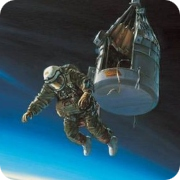
Joseph W. Kittinger and the Highest Step in the World
On August 16, 1960, US Air Force Captain Joseph W. Kittinger literally jumped into the pages of aviation history books when he stepped out of a balloon gondola at an altitude of 102,800 feet. For more than four and a half minutes, he plummeted towards the ground before finally opening his parachute at an altitude of 18,000 feet.
Aerospace writer Gregory Kennedy, tells us the details behind Project EXCELSIOR, one of the most daring endeavours ever conducted by the Air Force of the United States. The program, carried out in the late fifties, was looking for a safe way to allow the bail-out of pilots and future astronauts from extreme heights.

America's First Flight
North Carolina license plates proclaim their state "First in Flight". Ohio, birthplace of Orville and Wilbur Wright, claims to be the "birthplace of aviation". However, the first flight in North America took place in Philadelphia. Granted, it was a balloon, but Philadelphia can rightfully claim to be the site of the first flight in the United States.
In this brief article, aerospace writer Gregory Kennedy, makes a detailed account of the first balloon flight achieved in United States in 1793. Additionally, the author offers to the reader a glimpse of the personality, personal background and previous conquest of the french aeronaut Jean Pierre Blanchard.
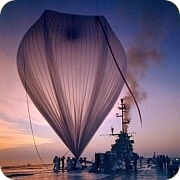
Stratolab, an Evolutionary Stratospheric Balloon Project
In many ways, Strato Lab can be perceived as an evolutionary stepping stone to space flight. Unlike the contemporary Manhigh program by the United States Air Force, which used a brand new capsule design and an innovative life support system, Strato Lab retained the configuration and certain design elements of balloon gondolas of the 1930s. Thus, it bridged the gap between pressurized gondola designs of the 1930s and modern spacecraft. In addition, Strato Lab was the first post-war balloon project to carry humans into the stratosphere and it pioneered having a trained scientist on board to make observations while a pilot handled the aircraft.
In the article, aerospace writer Gregory Kennedy, resumes the history of the U.S. NAVY's Stratolab manned balloon program.

A short history of the NSBF (CSBF)
In this article, Dwight Bawcom, former Operations Manager of the National Scientific Balloon Facility (now the Columbia Scientific Balloon Facility) paint us a short but comprehensive history of the NASA balloon program and the balloon facility itself.
As widely know since the sixties decade, and with more than 2000 stratospheric balloons launched in four continents the NSBF is one of the leading balloon groups in the world and accompanied since the balloon technology evolution.

